Analysis of HRM Practices and Proposed Solutions: Wakulima Kwanza
VerifiedAdded on 2023/01/19
|7
|1531
|93
Case Study
AI Summary
This assignment analyzes a case study centered on HRM practices within the Wakulima Kwanza organization, focusing on the challenges faced by a newly appointed Field Director, Mercyline, and the district's struggles with enrollment targets and staff turnover. The primary issue identified is the HR department's enrollment policies, which led to biased practices, impacting the workforce. The secondary issue is Mercyline's difficulty adapting to the tribal district's culture and the lack of effective communication between management and employees. The assignment proposes HR interventions, including communication with teammates, recruitment of skilled personnel, and amendments to HR policies, to mitigate the identified problems. A six-week action plan is presented, outlining steps to assess the situation, implement changes, and monitor outcomes, with KPIs focusing on improved employee retention and reduced turnover. The plan involves consultations with stakeholders, implementation of a no-discrimination policy, and regular monitoring of the process to ensure effectiveness.
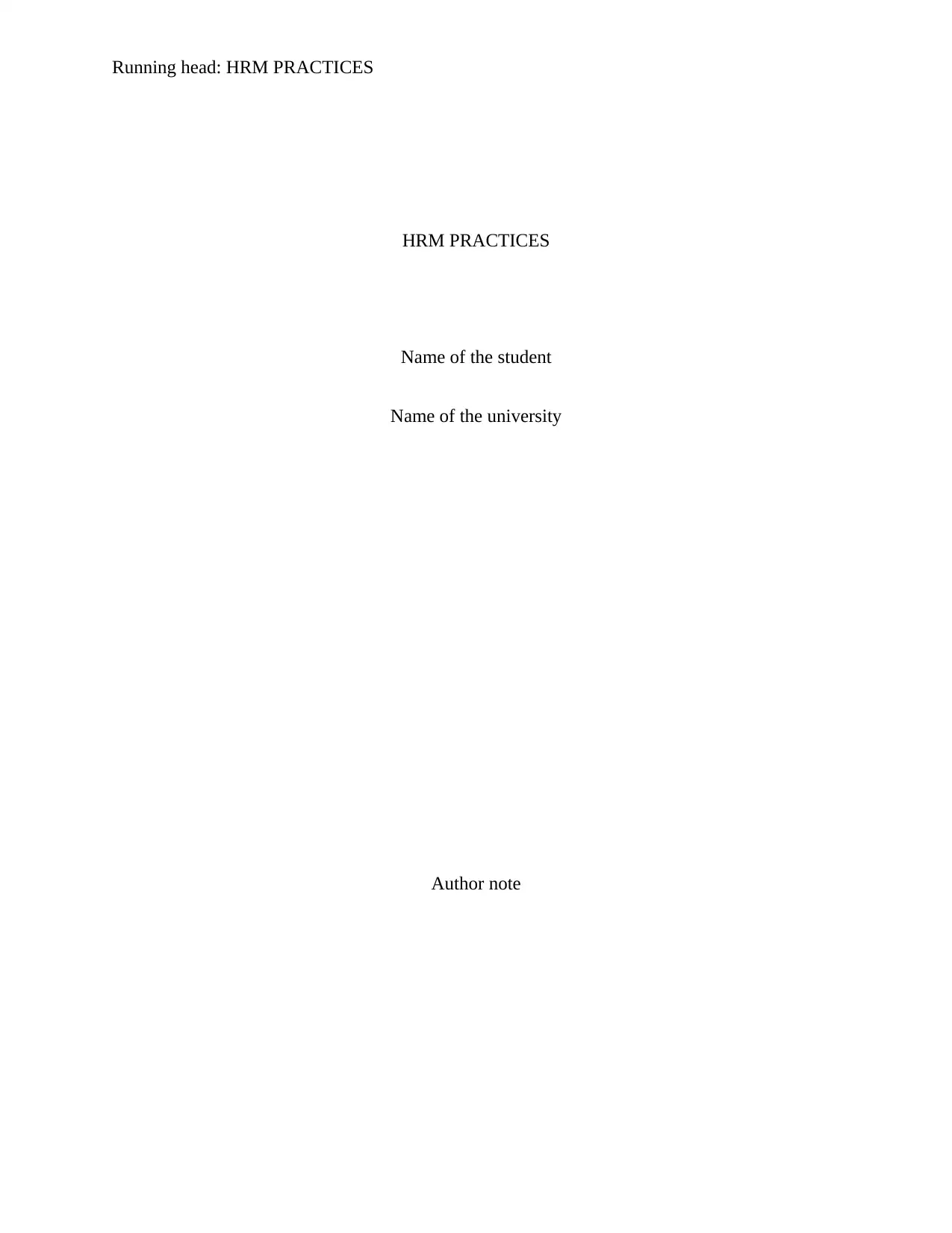
Running head: HRM PRACTICES
HRM PRACTICES
Name of the student
Name of the university
Author note
HRM PRACTICES
Name of the student
Name of the university
Author note
Paraphrase This Document
Need a fresh take? Get an instant paraphrase of this document with our AI Paraphraser
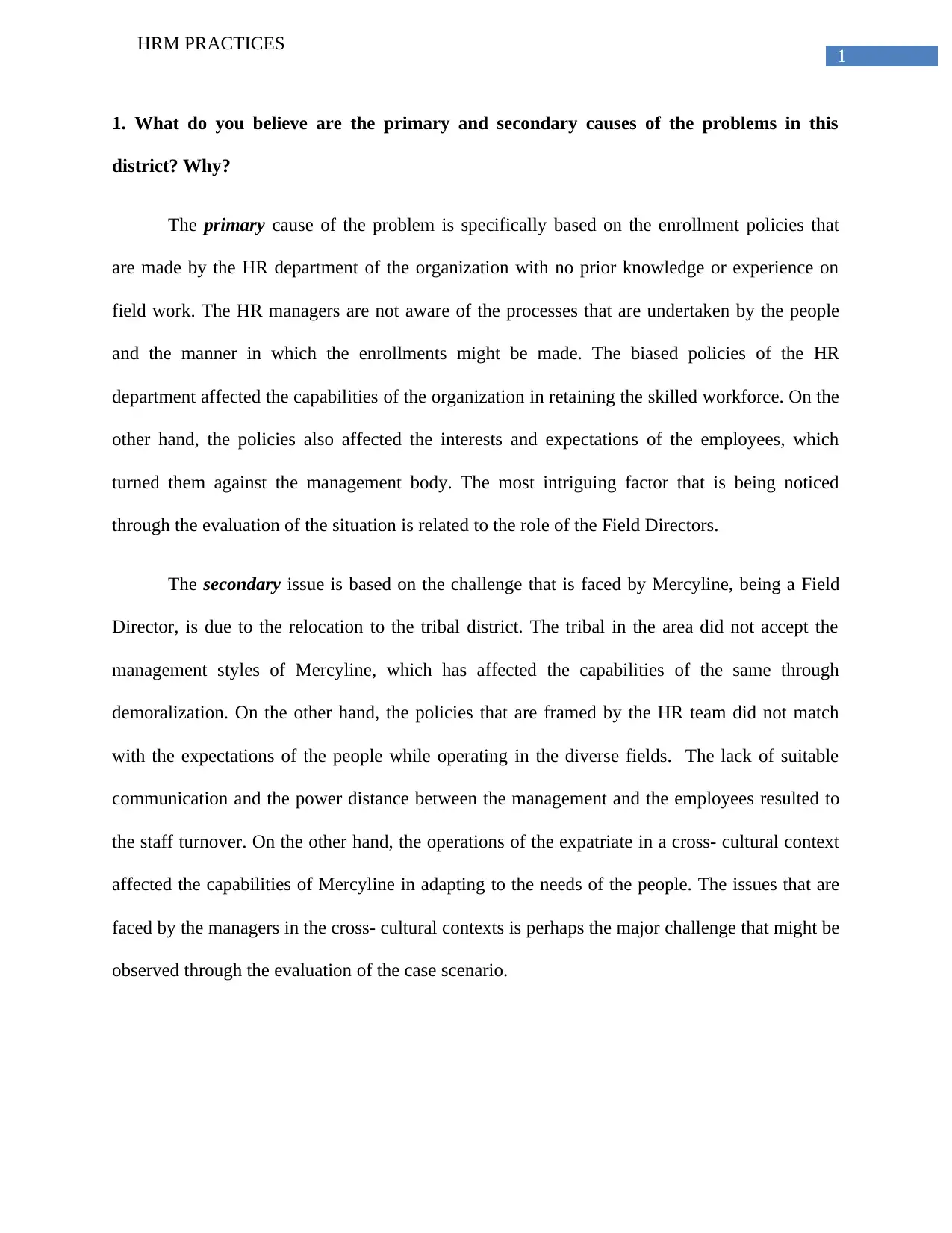
1
HRM PRACTICES
1. What do you believe are the primary and secondary causes of the problems in this
district? Why?
The primary cause of the problem is specifically based on the enrollment policies that
are made by the HR department of the organization with no prior knowledge or experience on
field work. The HR managers are not aware of the processes that are undertaken by the people
and the manner in which the enrollments might be made. The biased policies of the HR
department affected the capabilities of the organization in retaining the skilled workforce. On the
other hand, the policies also affected the interests and expectations of the employees, which
turned them against the management body. The most intriguing factor that is being noticed
through the evaluation of the situation is related to the role of the Field Directors.
The secondary issue is based on the challenge that is faced by Mercyline, being a Field
Director, is due to the relocation to the tribal district. The tribal in the area did not accept the
management styles of Mercyline, which has affected the capabilities of the same through
demoralization. On the other hand, the policies that are framed by the HR team did not match
with the expectations of the people while operating in the diverse fields. The lack of suitable
communication and the power distance between the management and the employees resulted to
the staff turnover. On the other hand, the operations of the expatriate in a cross- cultural context
affected the capabilities of Mercyline in adapting to the needs of the people. The issues that are
faced by the managers in the cross- cultural contexts is perhaps the major challenge that might be
observed through the evaluation of the case scenario.
HRM PRACTICES
1. What do you believe are the primary and secondary causes of the problems in this
district? Why?
The primary cause of the problem is specifically based on the enrollment policies that
are made by the HR department of the organization with no prior knowledge or experience on
field work. The HR managers are not aware of the processes that are undertaken by the people
and the manner in which the enrollments might be made. The biased policies of the HR
department affected the capabilities of the organization in retaining the skilled workforce. On the
other hand, the policies also affected the interests and expectations of the employees, which
turned them against the management body. The most intriguing factor that is being noticed
through the evaluation of the situation is related to the role of the Field Directors.
The secondary issue is based on the challenge that is faced by Mercyline, being a Field
Director, is due to the relocation to the tribal district. The tribal in the area did not accept the
management styles of Mercyline, which has affected the capabilities of the same through
demoralization. On the other hand, the policies that are framed by the HR team did not match
with the expectations of the people while operating in the diverse fields. The lack of suitable
communication and the power distance between the management and the employees resulted to
the staff turnover. On the other hand, the operations of the expatriate in a cross- cultural context
affected the capabilities of Mercyline in adapting to the needs of the people. The issues that are
faced by the managers in the cross- cultural contexts is perhaps the major challenge that might be
observed through the evaluation of the case scenario.
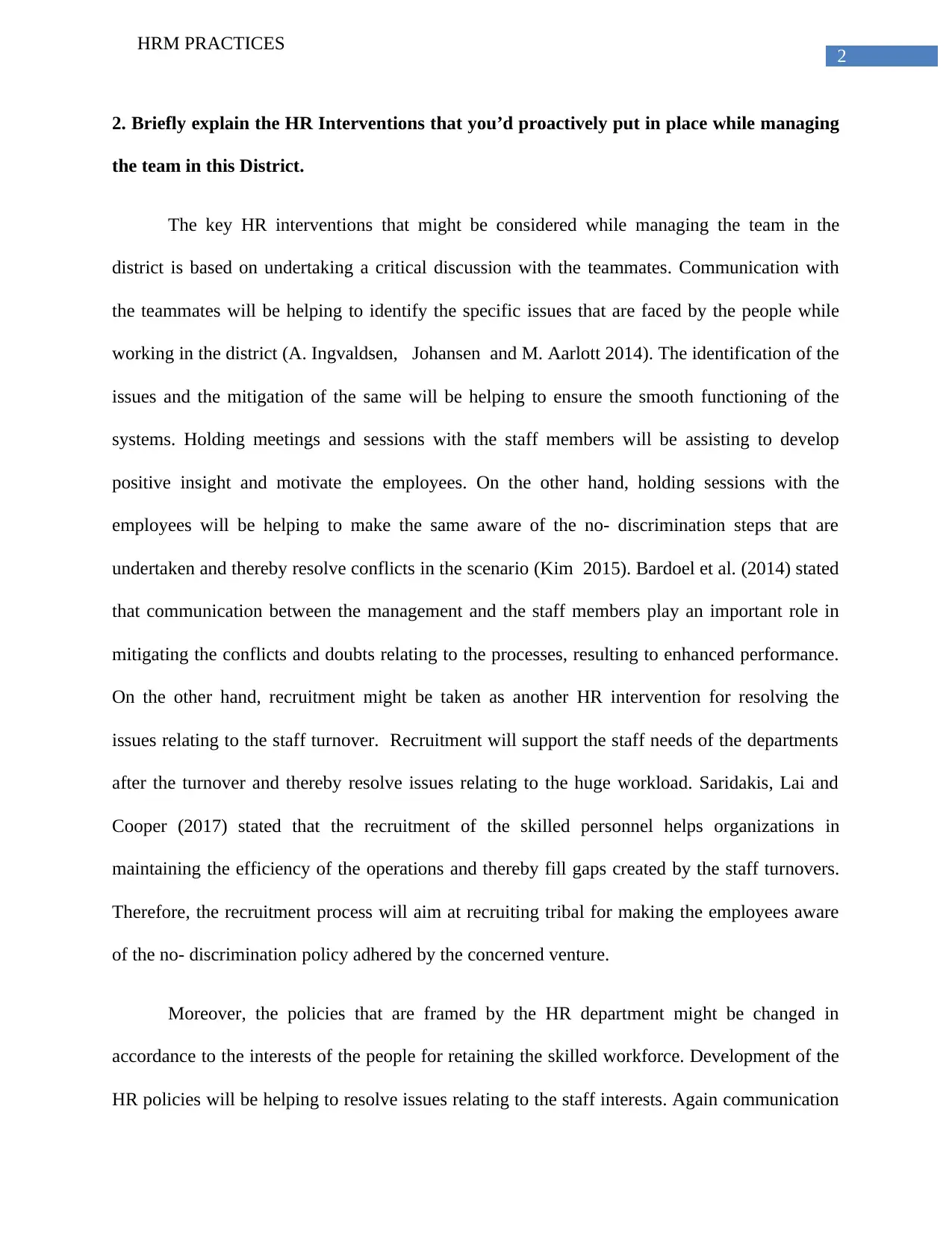
2
HRM PRACTICES
2. Briefly explain the HR Interventions that you’d proactively put in place while managing
the team in this District.
The key HR interventions that might be considered while managing the team in the
district is based on undertaking a critical discussion with the teammates. Communication with
the teammates will be helping to identify the specific issues that are faced by the people while
working in the district (A. Ingvaldsen, Johansen and M. Aarlott 2014). The identification of the
issues and the mitigation of the same will be helping to ensure the smooth functioning of the
systems. Holding meetings and sessions with the staff members will be assisting to develop
positive insight and motivate the employees. On the other hand, holding sessions with the
employees will be helping to make the same aware of the no- discrimination steps that are
undertaken and thereby resolve conflicts in the scenario (Kim 2015). Bardoel et al. (2014) stated
that communication between the management and the staff members play an important role in
mitigating the conflicts and doubts relating to the processes, resulting to enhanced performance.
On the other hand, recruitment might be taken as another HR intervention for resolving the
issues relating to the staff turnover. Recruitment will support the staff needs of the departments
after the turnover and thereby resolve issues relating to the huge workload. Saridakis, Lai and
Cooper (2017) stated that the recruitment of the skilled personnel helps organizations in
maintaining the efficiency of the operations and thereby fill gaps created by the staff turnovers.
Therefore, the recruitment process will aim at recruiting tribal for making the employees aware
of the no- discrimination policy adhered by the concerned venture.
Moreover, the policies that are framed by the HR department might be changed in
accordance to the interests of the people for retaining the skilled workforce. Development of the
HR policies will be helping to resolve issues relating to the staff interests. Again communication
HRM PRACTICES
2. Briefly explain the HR Interventions that you’d proactively put in place while managing
the team in this District.
The key HR interventions that might be considered while managing the team in the
district is based on undertaking a critical discussion with the teammates. Communication with
the teammates will be helping to identify the specific issues that are faced by the people while
working in the district (A. Ingvaldsen, Johansen and M. Aarlott 2014). The identification of the
issues and the mitigation of the same will be helping to ensure the smooth functioning of the
systems. Holding meetings and sessions with the staff members will be assisting to develop
positive insight and motivate the employees. On the other hand, holding sessions with the
employees will be helping to make the same aware of the no- discrimination steps that are
undertaken and thereby resolve conflicts in the scenario (Kim 2015). Bardoel et al. (2014) stated
that communication between the management and the staff members play an important role in
mitigating the conflicts and doubts relating to the processes, resulting to enhanced performance.
On the other hand, recruitment might be taken as another HR intervention for resolving the
issues relating to the staff turnover. Recruitment will support the staff needs of the departments
after the turnover and thereby resolve issues relating to the huge workload. Saridakis, Lai and
Cooper (2017) stated that the recruitment of the skilled personnel helps organizations in
maintaining the efficiency of the operations and thereby fill gaps created by the staff turnovers.
Therefore, the recruitment process will aim at recruiting tribal for making the employees aware
of the no- discrimination policy adhered by the concerned venture.
Moreover, the policies that are framed by the HR department might be changed in
accordance to the interests of the people for retaining the skilled workforce. Development of the
HR policies will be helping to resolve issues relating to the staff interests. Again communication
⊘ This is a preview!⊘
Do you want full access?
Subscribe today to unlock all pages.

Trusted by 1+ million students worldwide
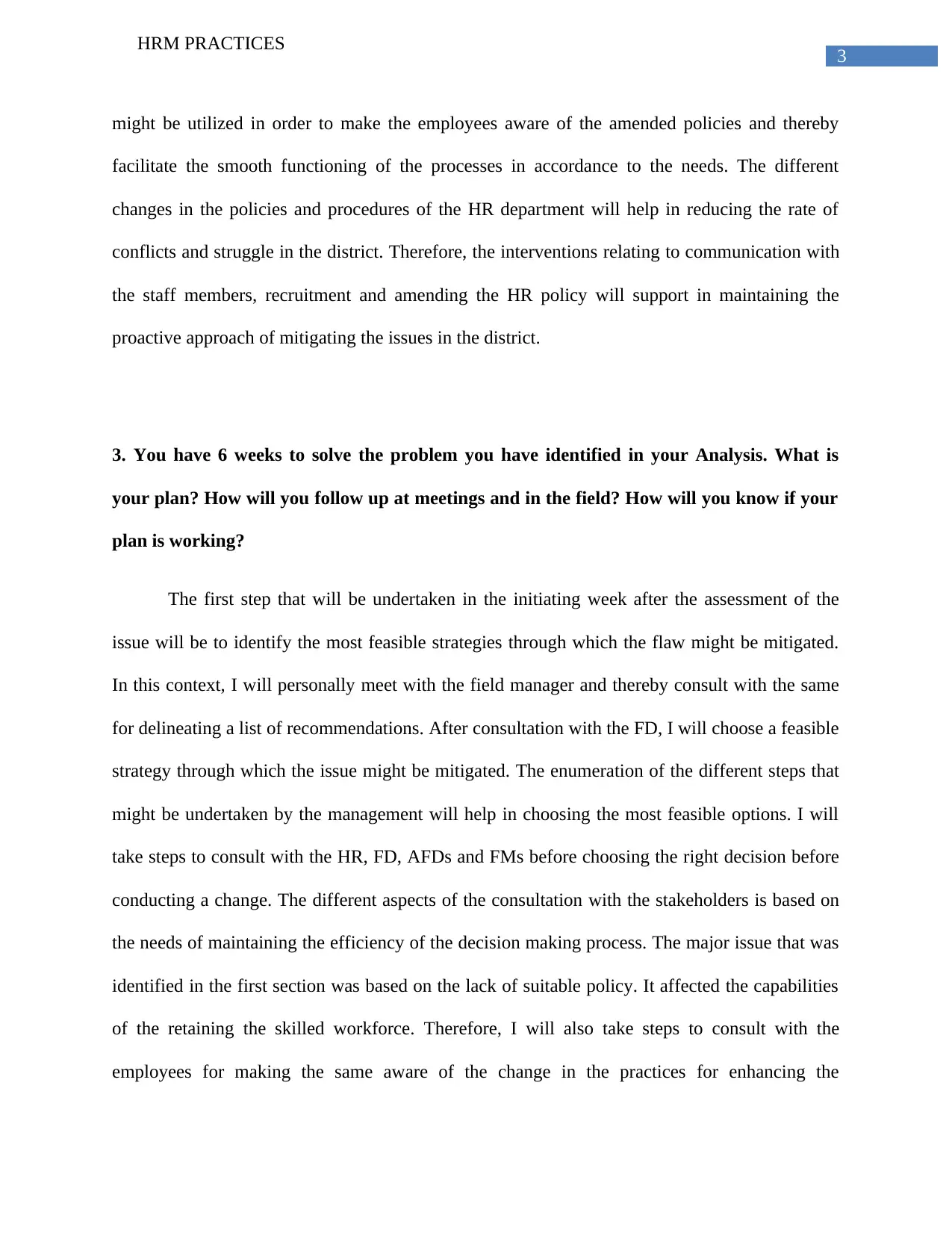
3
HRM PRACTICES
might be utilized in order to make the employees aware of the amended policies and thereby
facilitate the smooth functioning of the processes in accordance to the needs. The different
changes in the policies and procedures of the HR department will help in reducing the rate of
conflicts and struggle in the district. Therefore, the interventions relating to communication with
the staff members, recruitment and amending the HR policy will support in maintaining the
proactive approach of mitigating the issues in the district.
3. You have 6 weeks to solve the problem you have identified in your Analysis. What is
your plan? How will you follow up at meetings and in the field? How will you know if your
plan is working?
The first step that will be undertaken in the initiating week after the assessment of the
issue will be to identify the most feasible strategies through which the flaw might be mitigated.
In this context, I will personally meet with the field manager and thereby consult with the same
for delineating a list of recommendations. After consultation with the FD, I will choose a feasible
strategy through which the issue might be mitigated. The enumeration of the different steps that
might be undertaken by the management will help in choosing the most feasible options. I will
take steps to consult with the HR, FD, AFDs and FMs before choosing the right decision before
conducting a change. The different aspects of the consultation with the stakeholders is based on
the needs of maintaining the efficiency of the decision making process. The major issue that was
identified in the first section was based on the lack of suitable policy. It affected the capabilities
of the retaining the skilled workforce. Therefore, I will also take steps to consult with the
employees for making the same aware of the change in the practices for enhancing the
HRM PRACTICES
might be utilized in order to make the employees aware of the amended policies and thereby
facilitate the smooth functioning of the processes in accordance to the needs. The different
changes in the policies and procedures of the HR department will help in reducing the rate of
conflicts and struggle in the district. Therefore, the interventions relating to communication with
the staff members, recruitment and amending the HR policy will support in maintaining the
proactive approach of mitigating the issues in the district.
3. You have 6 weeks to solve the problem you have identified in your Analysis. What is
your plan? How will you follow up at meetings and in the field? How will you know if your
plan is working?
The first step that will be undertaken in the initiating week after the assessment of the
issue will be to identify the most feasible strategies through which the flaw might be mitigated.
In this context, I will personally meet with the field manager and thereby consult with the same
for delineating a list of recommendations. After consultation with the FD, I will choose a feasible
strategy through which the issue might be mitigated. The enumeration of the different steps that
might be undertaken by the management will help in choosing the most feasible options. I will
take steps to consult with the HR, FD, AFDs and FMs before choosing the right decision before
conducting a change. The different aspects of the consultation with the stakeholders is based on
the needs of maintaining the efficiency of the decision making process. The major issue that was
identified in the first section was based on the lack of suitable policy. It affected the capabilities
of the retaining the skilled workforce. Therefore, I will also take steps to consult with the
employees for making the same aware of the change in the practices for enhancing the
Paraphrase This Document
Need a fresh take? Get an instant paraphrase of this document with our AI Paraphraser
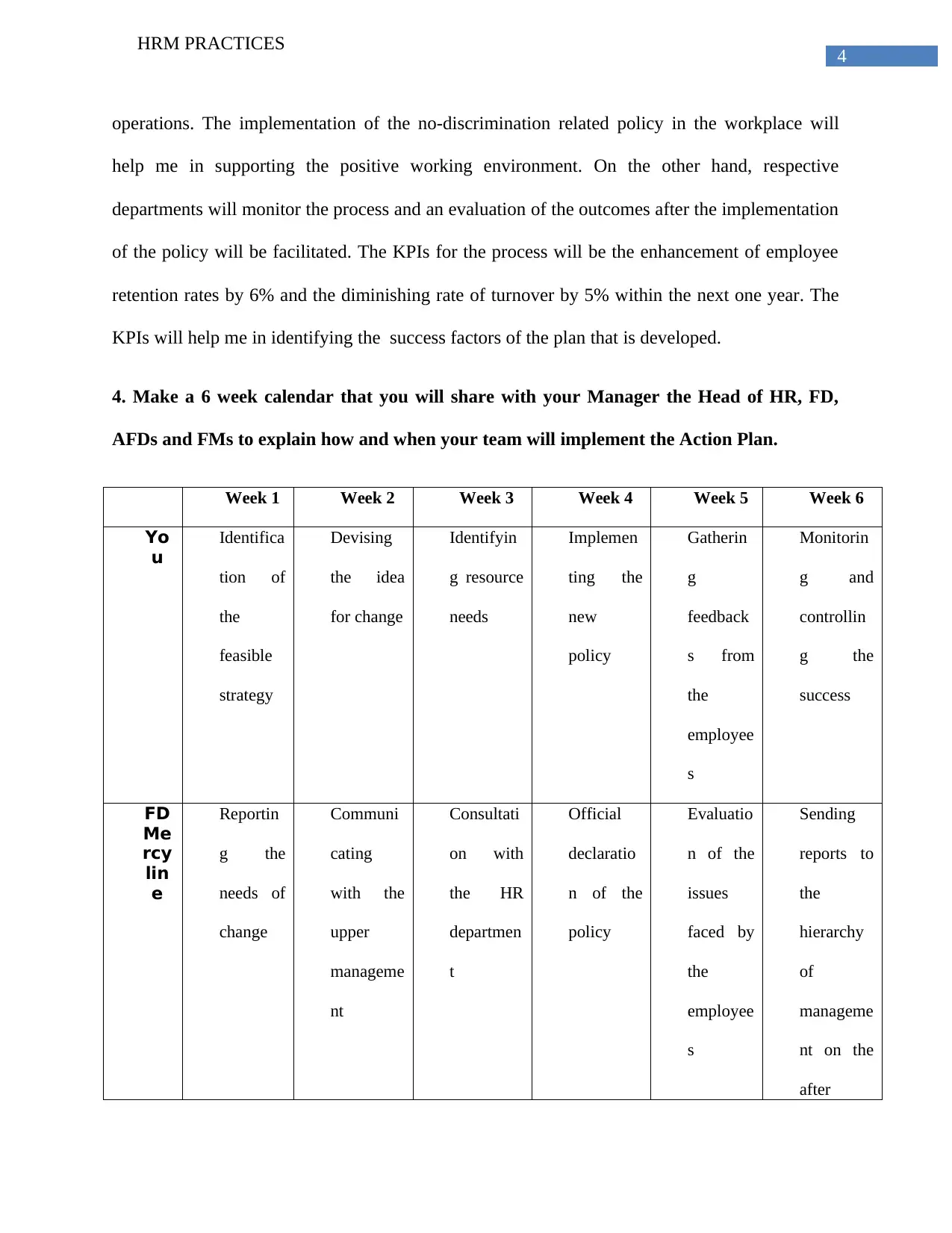
4
HRM PRACTICES
operations. The implementation of the no-discrimination related policy in the workplace will
help me in supporting the positive working environment. On the other hand, respective
departments will monitor the process and an evaluation of the outcomes after the implementation
of the policy will be facilitated. The KPIs for the process will be the enhancement of employee
retention rates by 6% and the diminishing rate of turnover by 5% within the next one year. The
KPIs will help me in identifying the success factors of the plan that is developed.
4. Make a 6 week calendar that you will share with your Manager the Head of HR, FD,
AFDs and FMs to explain how and when your team will implement the Action Plan.
Week 1 Week 2 Week 3 Week 4 Week 5 Week 6
Yo
u
Identifica
tion of
the
feasible
strategy
Devising
the idea
for change
Identifyin
g resource
needs
Implemen
ting the
new
policy
Gatherin
g
feedback
s from
the
employee
s
Monitorin
g and
controllin
g the
success
FD
Me
rcy
lin
e
Reportin
g the
needs of
change
Communi
cating
with the
upper
manageme
nt
Consultati
on with
the HR
departmen
t
Official
declaratio
n of the
policy
Evaluatio
n of the
issues
faced by
the
employee
s
Sending
reports to
the
hierarchy
of
manageme
nt on the
after
HRM PRACTICES
operations. The implementation of the no-discrimination related policy in the workplace will
help me in supporting the positive working environment. On the other hand, respective
departments will monitor the process and an evaluation of the outcomes after the implementation
of the policy will be facilitated. The KPIs for the process will be the enhancement of employee
retention rates by 6% and the diminishing rate of turnover by 5% within the next one year. The
KPIs will help me in identifying the success factors of the plan that is developed.
4. Make a 6 week calendar that you will share with your Manager the Head of HR, FD,
AFDs and FMs to explain how and when your team will implement the Action Plan.
Week 1 Week 2 Week 3 Week 4 Week 5 Week 6
Yo
u
Identifica
tion of
the
feasible
strategy
Devising
the idea
for change
Identifyin
g resource
needs
Implemen
ting the
new
policy
Gatherin
g
feedback
s from
the
employee
s
Monitorin
g and
controllin
g the
success
FD
Me
rcy
lin
e
Reportin
g the
needs of
change
Communi
cating
with the
upper
manageme
nt
Consultati
on with
the HR
departmen
t
Official
declaratio
n of the
policy
Evaluatio
n of the
issues
faced by
the
employee
s
Sending
reports to
the
hierarchy
of
manageme
nt on the
after
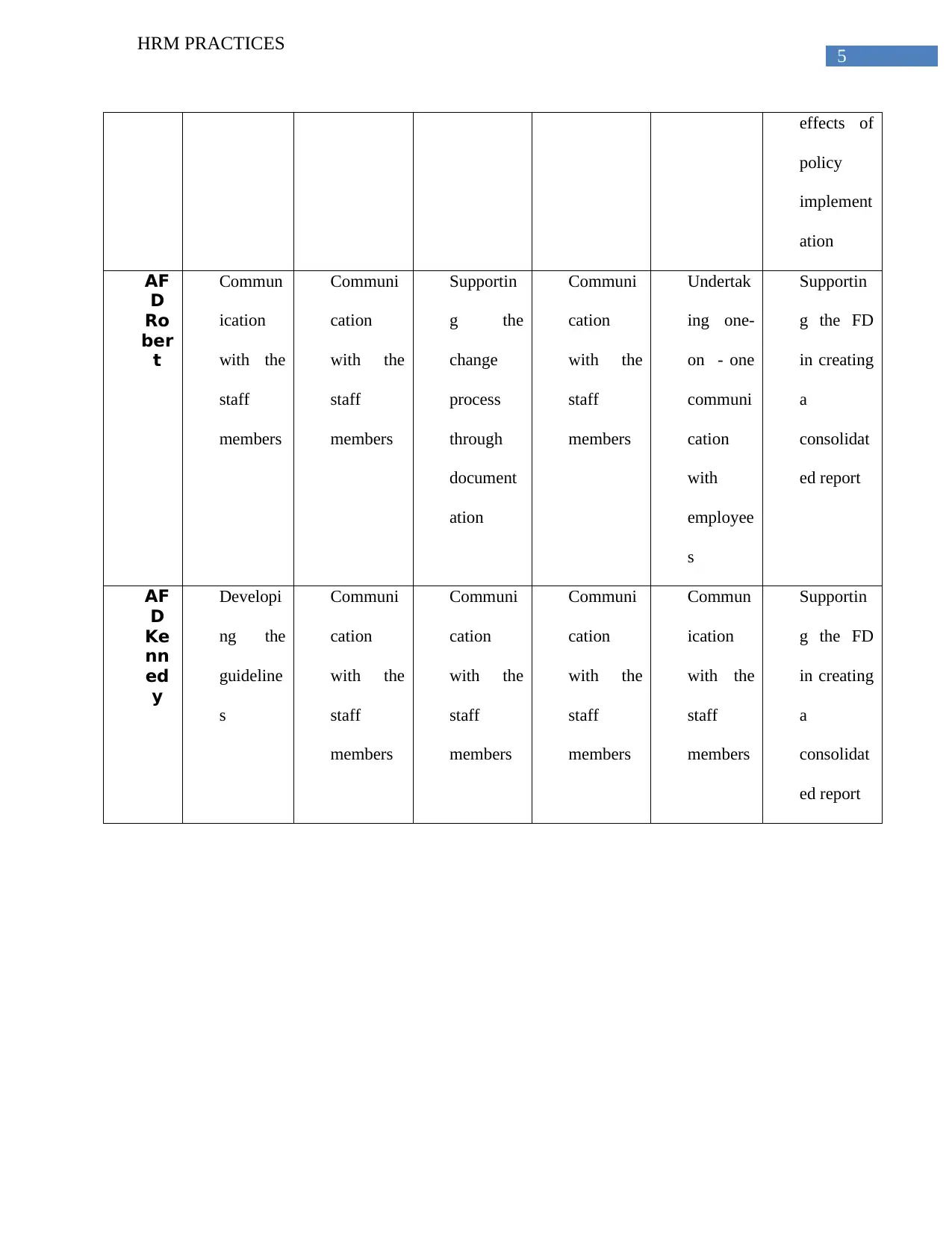
5
HRM PRACTICES
effects of
policy
implement
ation
AF
D
Ro
ber
t
Commun
ication
with the
staff
members
Communi
cation
with the
staff
members
Supportin
g the
change
process
through
document
ation
Communi
cation
with the
staff
members
Undertak
ing one-
on - one
communi
cation
with
employee
s
Supportin
g the FD
in creating
a
consolidat
ed report
AF
D
Ke
nn
ed
y
Developi
ng the
guideline
s
Communi
cation
with the
staff
members
Communi
cation
with the
staff
members
Communi
cation
with the
staff
members
Commun
ication
with the
staff
members
Supportin
g the FD
in creating
a
consolidat
ed report
HRM PRACTICES
effects of
policy
implement
ation
AF
D
Ro
ber
t
Commun
ication
with the
staff
members
Communi
cation
with the
staff
members
Supportin
g the
change
process
through
document
ation
Communi
cation
with the
staff
members
Undertak
ing one-
on - one
communi
cation
with
employee
s
Supportin
g the FD
in creating
a
consolidat
ed report
AF
D
Ke
nn
ed
y
Developi
ng the
guideline
s
Communi
cation
with the
staff
members
Communi
cation
with the
staff
members
Communi
cation
with the
staff
members
Commun
ication
with the
staff
members
Supportin
g the FD
in creating
a
consolidat
ed report
⊘ This is a preview!⊘
Do you want full access?
Subscribe today to unlock all pages.

Trusted by 1+ million students worldwide
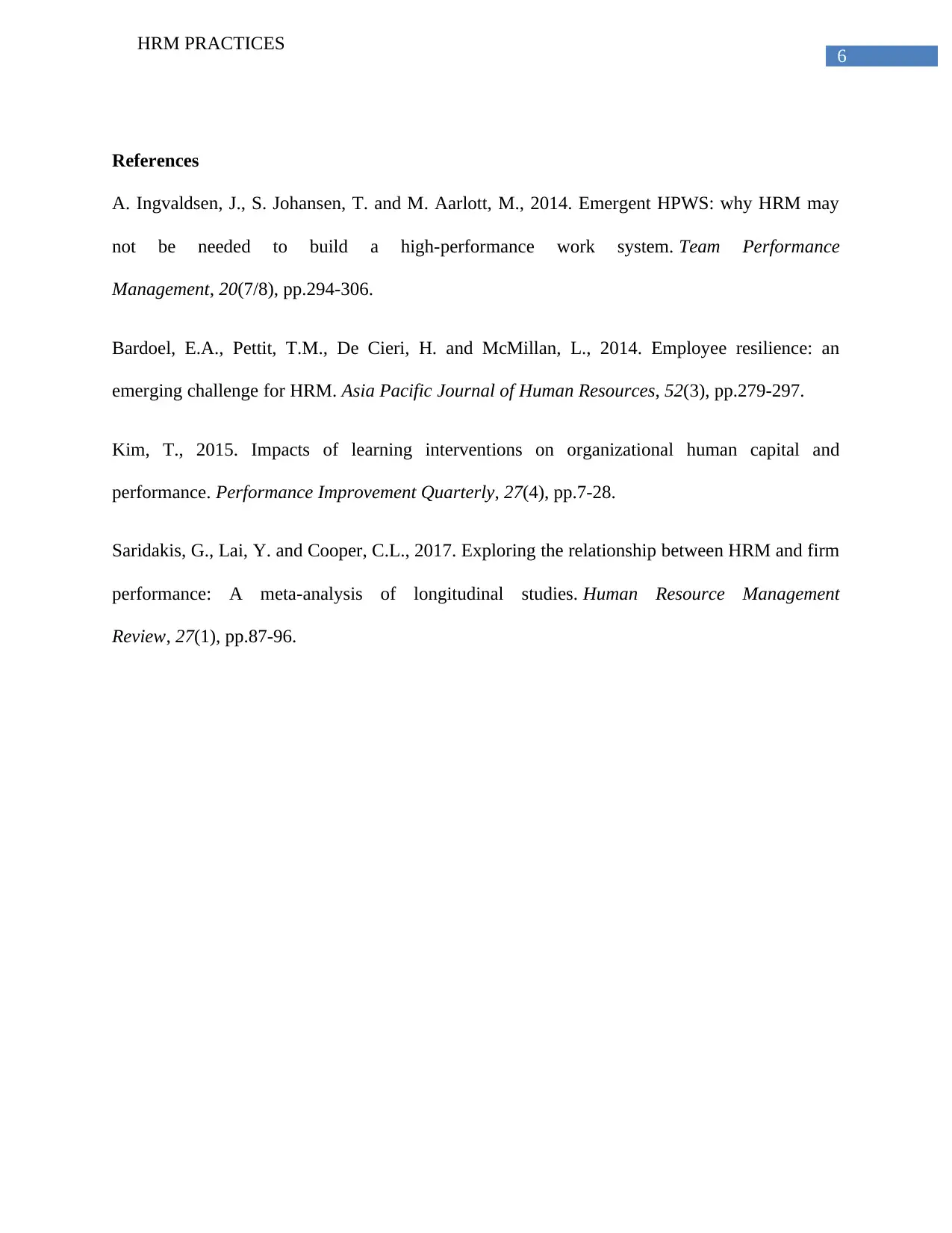
6
HRM PRACTICES
References
A. Ingvaldsen, J., S. Johansen, T. and M. Aarlott, M., 2014. Emergent HPWS: why HRM may
not be needed to build a high-performance work system. Team Performance
Management, 20(7/8), pp.294-306.
Bardoel, E.A., Pettit, T.M., De Cieri, H. and McMillan, L., 2014. Employee resilience: an
emerging challenge for HRM. Asia Pacific Journal of Human Resources, 52(3), pp.279-297.
Kim, T., 2015. Impacts of learning interventions on organizational human capital and
performance. Performance Improvement Quarterly, 27(4), pp.7-28.
Saridakis, G., Lai, Y. and Cooper, C.L., 2017. Exploring the relationship between HRM and firm
performance: A meta-analysis of longitudinal studies. Human Resource Management
Review, 27(1), pp.87-96.
HRM PRACTICES
References
A. Ingvaldsen, J., S. Johansen, T. and M. Aarlott, M., 2014. Emergent HPWS: why HRM may
not be needed to build a high-performance work system. Team Performance
Management, 20(7/8), pp.294-306.
Bardoel, E.A., Pettit, T.M., De Cieri, H. and McMillan, L., 2014. Employee resilience: an
emerging challenge for HRM. Asia Pacific Journal of Human Resources, 52(3), pp.279-297.
Kim, T., 2015. Impacts of learning interventions on organizational human capital and
performance. Performance Improvement Quarterly, 27(4), pp.7-28.
Saridakis, G., Lai, Y. and Cooper, C.L., 2017. Exploring the relationship between HRM and firm
performance: A meta-analysis of longitudinal studies. Human Resource Management
Review, 27(1), pp.87-96.
1 out of 7
Related Documents
Your All-in-One AI-Powered Toolkit for Academic Success.
+13062052269
info@desklib.com
Available 24*7 on WhatsApp / Email
![[object Object]](/_next/static/media/star-bottom.7253800d.svg)
Unlock your academic potential
Copyright © 2020–2025 A2Z Services. All Rights Reserved. Developed and managed by ZUCOL.





